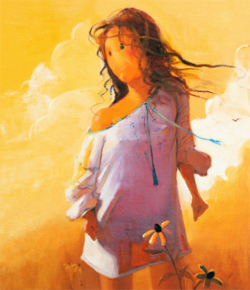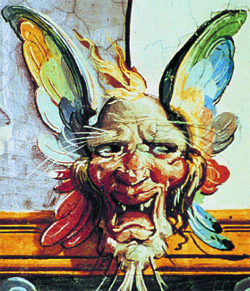Putting Grotesque to the Test: Site Santa Fe's Fifth International
Biennial |
By Lyz Nagan
|

Plastic rats and muddied baby dolls welcome the audience to the fifth annual
SITE Santa Fe biennial held at the newly revamped space of the not-for-profit
contemporary art organization. I spent my entire life in the Midwest�teal, purple,
and unnaturally orange landscapes come to mind when I envision New Mexico�s
art scene. Perhaps I am not the only one who imagines Santa Fe as a regional
art center because SITE�s mission is to explicitly bring international art to
Santa Fe. Although the exhibiting artists are mostly American, the biennial�s
guest curator, Robert Storr, cranked up the Santa Fe art scene by more than
a couple of notches with Disparities and Deformations: Our Grotesque.
Storr has long been interested in the subject of the grotesque, evidenced by
the precision and clarity of this show. With the lofty goal of reclaiming the
concept from abuse by the media, Storr approaches this show as a chance to complicate
the term and the images it describes. Rather than simplify and explain the concept,
Storr explores the polyvalence and slipperiness.
I wandered through the impressive show with just general knowledge of the history
and complexity of the grotesque, and therefore armed mostly with my eyes. The
exterior installation, by Kim Jones, is a collage of trashy items�bundles of
twigs, used grills, suspended dolls and marching rats. The clever result embodies
the uneasiness and whimsicality of the theme, but also misleads the audience
as to the range of work inside.
Jones�s contribution continues in the entryway of the building, and though his
drawings are intriguingly detailed and well crafted, they are not nearly as
ambiguous and exploratory as other works in the show.
Once inside, it is apparent that Storr is a skilled curator�the exhibition flow
and attuned placement of the works is staggering. Apart from the difficulty
of viewing drawings through reflective glass in the sunny foyer, the drawings
feel like adolescent sketches gone too far�with none of the innocence and all
of the darkness.
Hung on the adjacent wall is a thematically relevant Jeff Wall photograph. Intimately
scaled, the photo portrays a common nightmarish scene of being caught naked
in public. In this case, a nude, older woman towers over the central staircase
of a library completely oblivious to the comings and goings of the library visitors.
The serenity of the scene combined with the woman�s shameless disposition makes
the piece a perfect introduction to the rest of the show.
Connecting the entryway to the meat of the exhibition was Ricci Albenda�s �Tesseract,�
a quirky take on the white-walled spaces to which modern art audiences are accustomed.
The organically styled reliefs and engravings make glaringly apparent the flat,
stark walls that support our once (and maybe still) radical art. The architectural
possibilities, he seems to be saying, are endless, and yet look how, we repeatedly
use the space. Beyond this installation, six large galleries (and one old railroad
car) housed the remaining 50 artists.
Historically, the concept of the grotesque relied on fantastic imagery to challenge
and critique mainstream values and sensibilities. Many of the works continue
this tradition. Issues of race, gender, sexuality and religion abound, making
the show a feast for the mind as well as the senses.
The discomfort that some may attribute to grotesque images stems directly from
the confronting quality in images that twist and contort our preconceived notions
of beauty and nature. As Storr brilliantly observed in the introduction to the
catalog, the artists in the show extract the unnatural from the natural.
Among the notable inclusions in the show are Lamar Peterson�s stoic scenes of
homicidal sock-monkeys and a mother gleefully smiling while her son�s face melts
to the floor; Lisa Yuskavage�s soft portraits of oddly proportioned women; Adriana
Varej�o�s tile sculpture reminiscent of excavated ruins with decorative motifs
and bloodied innards; Kara Walker�s first video, made specifically for this
show, portraying a racist society turned upside down in raw, puppet show fashion;
Louise Bourgeois�s psychological cell with three suspended heads evoking the
trinity of the id, ego and superego; and occupying the always hazy boundary
between high art and low art, R. Crumb�s expertly executed cartoons of morphing
faces and boyish daydreams scribbled on caf� placemats.
But anchoring the constellation of meanings and possibilities of the grotesque
are works by Jenny Saville and Tony Oursler. Saville�s immense �Rueben�s Flap�
exaggerates the common female nude into ripples of flesh; rather than splayed
daintily on a daybed, the woman is upright and in your face. And though the
piece reeks of sensuality, the woman�s body also resists instantaneous sexulization
by the viewer, for the overweight, domineering lover isn�t easy to admit into
our fantasies. The three bodies meet and diverge, moving and flirting with the
viewer, while the faces exude pain, pleasure and obvious sexual agency. The
work at once captivates the viewer with its beauty and its horror, inciting
the ultimate grotesque experience. Saville�s canvas is monumentally hung in
the most prominent location in the space�Storr clearly thought of her work as
emblematic of the power of the grotesque.
Tony Oursler�s warped projection character �Softy� was captivating, almost charming,
its doll-like quality juxtaposed with a creepy, baby-talk babble soundtrack.
An almost circular blob, �Softy,� has a neon yellow face with droopy eyes, a
pink mouth, and a hijacked nose. Awkward and yet lovable, Oursler�s piece plays
with our standards of cuteness. The nursery colors begin to look psychedelic
on the oversized face, and the nonsensical phrases sound almost maniacal when
uttered in mostly monotonous tones and on a looped track. �Softy� throws into
question the innocence and naivet� of children�s toys, or perhaps more accurately,
the �projected� innocence and naivet� of children�s toys.
We are bombarded with beauty everyday, from supermodels to Monet�s haystacks,
and it is about time we start reflecting on what and why we consider an image
beautiful. The grotesque is the perfect remedy to complacent taste, occupying
both good and bad territories simultaneously.
The inherent ambiguity and tension in the works makes it impossible to walk
through the exhibition with only a half-awakened eye; juxtapositions of unlikely
pairings, unintelligible, yet life-like figures and imaginative reworkings of
images we take for granted in our daily life make us aware of the sensibilities
we carry with us everywhere we go. Storr successfully stirs up the meaning of
the grotesque but also the meanings of beauty, horror, ugliness, and humor.

